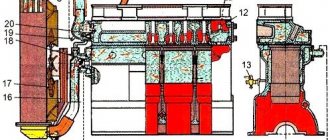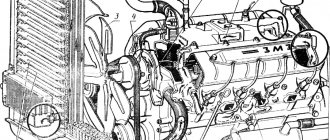Converting kilograms, centners and tons to liters can be done using any publicly available online unit converter. Such applications are suitable for solving most mathematical and physical problems. But when it comes to fuel, in particular gasoline, a simple translation is not enough. To correctly calculate the number of liters in one ton of fuel, you will need to take into account some other characteristics of the fuel.
How to calculate the density of gasoline?
4. How to measure density
- take any container with graduated divisions;
- weigh the container;
- pour 100 ml of fuel into the container;
- weigh the liquid and find the difference in measurement values;
- divide the result by the volume of fuel.
Aug 9
2022 Interesting materials:
How to store mushroom powder? How to store elderberries? How to store zucchini for first feeding? How to store potatoes in a warm basement? How to store potatoes if it is not possible in the basement? How to store potatoes? How to store bread so it doesn't dry out? How to store jellied meat in the freezer? How to store cranberries on the balcony? How to store coconut paste?
Temperature dependence and conversion factor
It will be more difficult to answer the question of what formula to use to convert gasoline from liters to tons or vice versa under changing environmental conditions. Previously, we made calculations based on the fact that the fuel temperature is +15 degrees. How to calculate the mass of fuel in any volume if the temperature fluctuates?
Gasoline is a heat-sensitive substance. When heated, the volume of fuel increases, while its nominal density decreases. This property makes it much more difficult to calculate the amount of fuel purchased or consumed, which can distort the reliability of financial documents. Therefore, the tax authorities of the Russian Federation require that the mass and volume of products be calculated taking into account the temperature coefficient.
The basis for the calculation methodology is:
- GOST 2084-77 “Automotive gasolines. Technical conditions";
- Letter of the Federal Tax Service of the Russian Federation dated March 24, 2005 N 03-3-09/0412/23 “On the procedure for converting the amount of petroleum products from volume units to weight units.”
The same documents determine that it is necessary to establish the exact density of a specific gasoline label using special reference tables that determine the specific parameter in increments of 1 degree Celsius.
Having established a specific value for the density of gasoline at a specific temperature, you can use the general conversion formula, which is given in this article.
Another way to determine mass under conditions of temperature change is by calculation taking into account the conversion factor. It happens as follows:
- The documentation for the brand of gasoline indicates the density of the substance at a temperature of +20 (or +15, depending on the fuel) degrees;
- We measure the nominal temperature value in the fuel tank;
- We calculate the difference between the obtained result and the standard +20 degrees;
- In the table of coefficients, we look for the value of the correction by 1 degree specifically for the density value indicated in the product passport;
- We multiply the temperature difference by the found coefficient;
- Next are two options. If the temperature in the tank is more than +20 degrees, then from the standard density we subtract the number obtained in the previous paragraph. If the temperature is below +20 degrees, then we add the number.
The density of gasoline in most cases ranges from 720 to 780 kg/m3. We convert the data to g/cm3 and get the following table:
Table 1
Gasoline density values and conversion factors
| Density for +20 C | Conversion factor per 1 degree |
| 0,720 — 0,729 | 0,870 * 10^(-3) |
| 0,730 — 0,739 | 0,857 * 10^(-3) |
| 0,740 — 0,749 | 0,844 * 10^(-3) |
| 0,750 — 0,759 | 0,831 * 10^(-3) |
| 0,760 — 0,769 | 0,818 * 10^(-3) |
| 0,770 — 0,779 | 0,805 * 10^(-3) |
A simple example of a translation calculator. Let’s say the temperature difference is –5 degrees (the temperature inside the fuel tank is +15 degrees). At the same time, the density of gasoline at a temperature of +20, indicated in the documentation, is 740 kg/m3, that is, 0.740 g/cm3. The current correction for this fuel, based on the table data, is 0.844 * 10^(-3) for each degree. For five degrees, the correction will already be 0.844 * 10^(-3) * 5 = 0.0042 g/cm3. Since the temperature in the tank is below normal, we add the resulting coefficient to the initial density: 0.740 + 0.0042 = 0.7442 g/cm3 or 744 kg/m3.
#Petrol
Convert liters of fuel to tons
Having studied in detail the formulas for converting petroleum products into kilograms, it becomes clear that the density of water is much greater than that of fuel. Therefore, you can see flammable fuel stains in puddles at gas stations.
For convenience, we present formulas for converting liters of fuel to tons. To use them, you only need to know the amount of fuel you want to transfer. Next, follow the calculations using the formula:
- AI-76 = (Number of liters x 0.715) / 1000;
- AI-92 = (Quantity x 0.735) / 1000;
- AI-95 = (Quantity x 0.750) / 1000;
- AI-98 = (Quantity x 0.777) / 1000;
- summer diesel = (Quantity x 0.86) / 1000;
- winter diesel fuel = (Quantity x 0.84) / 1000;
- Arctic = (Quantity x 0.83) / 1000.
YouTube responded with an error: The request cannot be completed because you have exceeded your quota.
Bibliography:
- Gasoline - Wikipedia
- Economides, M. The color of oil. The world's largest business: history, money and politics / Economides M., Olini R. Publishing house: “Olympus-Business”, 2004. 256 p.
- PJSC "Tatneft" - Main portal "Tatneft"
- RussNeft - www.russneft.ru
Age and sex composition of the population of Bashkiria
The national female to male ratio is approximately 1.1. Moreover, at an early age the number of boys exceeds the number of girls, but with age the picture changes to the opposite. Looking at the population of Bashkiria, one can see that this trend continues here. On average, there are 1,139 women for every thousand men.
The distribution of the population by age in the Republic of Bashkiria is as follows: younger than working age - 750 thousand people, older than working age - 830 thousand people, working age - 2.4 million people. Thus, for every 1,000 people of working age there are about 600 young and old people. On average, this corresponds to all-Russian trends. The gender and age model of Bashkiria makes it possible to classify the region as an aging type, which indicates a future complication of the demographic and economic situation in the region.
Volume units
Cubic meter
The SI unit of volume is the cubic meter. The standard definition of one cubic meter is the volume of a cube with edges one meter long. Derived units such as cubic centimeters are also widely used.
Liter
The liter is one of the most commonly used units in the metric system. It is equal to the volume of a cube with edges 10 cm long: 1 liter = 10 cm × 10 cm × 10 cm = 1000 cubic centimeters
This is the same as 0.001 cubic meters. The mass of one liter of water at a temperature of 4°C is approximately equal to one kilogram. Milliliters, equal to one cubic centimeter or 1/1000 of a liter, are also often used. Milliliter is usually denoted as ml.
Jill
Gills are units of volume used in the United States to measure alcoholic beverages. One jill is five fluid ounces in the British Imperial system or four in the American system. One American jill is equal to a quarter of a pint or half a cup. Irish pubs serve strong drinks in portions of a quarter jill, or 35.5 milliliters. In Scotland, servings are smaller - one-fifth of a jill, or 28.4 milliliters. In England, until recently, portions were even smaller, just one-sixth of a jill or 23.7 milliliters. Now, it’s 25 or 35 milliliters, depending on the rules of the establishment. The owners can decide for themselves which of the two portions to serve.
Dram
Dram, or drachma, is a measure of volume, mass, and also a coin. In the past, this measure was used in pharmacy and was equal to one teaspoon. Later, the standard volume of a teaspoon changed, and one spoon became equal to 1 and 1/3 drachms.
In Bashkiria, both the birth rate and death rate decreased in the first quarter of 2022
Infant mortality has also increased: in January-March last year, 72 infants (children under the age of 1 year) died, in the first quarter of this year - 76. The Ministry of Health expects to overcome the problem by implementing the action plan defined by the national project “Health”. The causes of death remain the same. Mortality from cardiovascular diseases increased by 16%, mortality from cancer decreased by 3%, and from external causes - by 29%. But at the same time, the death rate from road accidents increased by 30% - in the first quarter, 21 more people died on the roads. Earlier, Bashinform reported that scientists from the Institute of Strategic Studies of Bashkiria have recorded certain features of the distribution of causes of death depending on place of residence. Most people die from infections and cancer in cities. In villages, the most common causes of death are diseases of the respiratory system, digestion, genitourinary system and external causes.
Ways to save
In addition to knowing the specifics of converting volume units, a household consumer must know the rules for saving resources in order to reduce the amount of water consumed:
- eliminate leaks from taps - even minor digging can lead to a serious loss of resources;
- do not leave water open unless necessary;
- soak plates before washing to reduce the duration of the procedure;
- use a diffuser on the kitchen faucet;
- find useful uses for used water;
- instead of taking baths, wash in the shower;
- use water heating with a boiler;
- select the optimal diameter of pipelines for the water supply.
These simple measures will help minimize unnecessary energy consumption and reduce the size of utility bills.
Converting the unit of measurement for water, like other liquids, from cubic meters to liters is not difficult. But for convenience and to obtain more accurate data, the volume is also displayed on the meters in fractions of a cubic meter, indicated in red. In this case, the third digit after the decimal point will indicate the number of liters.
?
, , . , ( – 4,546 , – 3,785 .) .
| , | (.), | (.), . | (12), | |
| 50% | 1310 | 6,0 | 5,0 | 15,7 |
| 92% | 1500 | 6,8 | 5,7 | 18,0 |
| 100% | 1513 | 6,9 | 5,7 | 18,2 |
| 610 | 2,8 | 2,3 | 7,3 | |
| 25% | 907 | 4,1 | 3,4 | 10,9 |
| 1022 | 4,6 | 3,9 | 12,3 | |
| 791 | 3,6 | 3,0 | 9,5 | |
| 760 | 3,5 | 2,9 | 9,1 | |
| 879 | 4,0 | 3,3 | 10,5 | |
| 810 | 3,7 | 3,1 | 9,7 | |
| 998 | 4,5 | 3,8 | 12,0 | |
| 660 | 3,0 | 2,5 | 7,9 | |
| 50% | 1126 | 5,1 | 4,3 | 13,5 |
| 80% | 1130 | 5,1 | 4,3 | 13,6 |
| 100% | 1270 | 5,8 | 4,8 | 15,2 |
| 1383 | 6,3 | 5,2 | 16,6 | |
| 1254 | 5,7 | 4,7 | 15,0 | |
| 714 | 3,2 | 2,7 | 8,6 | |
| 785 | 3,6 | 3,0 | 9,4 | |
| 25% | 1230 | 5,6 | 4,7 | 14,8 |
| 850 | 3,9 | 3,2 | 10,2 | |
| 880 | 4,0 | 3,3 | 10,6 | |
| 910 | 4,1 | 3,4 | 10,9 | |
| 30% | 950 | 4,3 | 3,6 | 11,4 |
| 40% | 935 | 4,3 | 3,5 | 11,2 |
| 90% | 820 | 3,7 | 3,1 | 9,8 |
| 100% | 792 | 3,6 | 3,0 | 9,5 |
| 1220 | 5,5 | 4,6 | 14,6 | |
| 10% | 1109 | 5,0 | 4,2 | 13,3 |
| 20% | 1219 | 5,5 | 4,6 | 14,6 |
| 30% | 1328 | 6,0 | 5,0 | 15,9 |
| 40% | 1430 | 6,5 | 5,4 | 17,2 |
| 50% | 1525 | 6,9 | 5,8 | 18,3 |
| 20% | 1148 | 5,2 | 4,3 | 13,8 |
| 1100 | 5,0 | 4,2 | 13,2 | |
| 870 | 4,0 | 3,3 | 10,4 | |
| 1203 | 5,5 | 4,6 | 14,4 | |
| 702 | 3,2 | 2,7 | 8,4 | |
| 20% | 1896 | 8,6 | 7,2 | 22,8 |
| 804 | 3,7 | 3,0 | 9,6 | |
| 30% | 1220 | 5,5 | 4,6 | 14,6 |
| 60% | 1498 | 6,8 | 5,7 | 18,0 |
| 75% | 1669 | 7,6 | 6,3 | 20,0 |
| 92% | 1824 | 8,3 | 6,9 | 21,9 |
| 98% | 1837 | 8,4 | 7,0 | 22,0 |
| 1263 | 5,7 | 4,8 | 15,2 | |
| 30% | 1149 | 5,2 | 4,3 | 13,8 |
| 1594 | 7,2 | 6,0 | 19,1 | |
| 866 | 3,9 | 3,3 | 10,4 | |
| 30% | 1040 | 4,7 | 3,9 | 12,5 |
| 50% | 1058 | 4,8 | 4,0 | 12,7 |
| 70% | 1070 | 4,9 | 4,0 | 12,8 |
| 100% | 1048 | 4,8 | 4,0 | 12,6 |
| 1075 | 4,9 | 4,1 | 12,9 | |
| 1107 | 5,0 | 4,2 | 13,3 | |
| 1489 | 6,8 | 5,6 | 17,9 | |
| 901 | 4,1 | 3,4 | 10,8 | |
| 1280 | 5,8 | 4,8 | 15,4 | |
| 10% | 980 | 4,5 | 3,7 | 11,8 |
| 20% | 969 | 4,4 | 3,7 | 11,6 |
| 40% | 935 | 4,3 | 3,5 | 11,2 |
| 60% | 891 | 4,1 | 3,4 | 10,7 |
| 70% | 850 | 3,9 | 3,2 | 10,2 |
| 80% | 843 | 3,8 | 3,2 | 10,1 |
| 100% | 789 | 3,6 | 3,0 | 9,5 |
Volume calculation
Liquid displacement method
The volume of an object can be calculated using the fluid displacement method. To do this, it is lowered into a liquid of a known volume, a new volume is geometrically calculated or measured, and the difference between these two quantities is the volume of the object being measured. For example, if when you lower an object into a cup with one liter of water, the volume of the liquid increases to two liters, then the volume of the object is one liter. In this way, you can only calculate the volume of objects that do not absorb liquid.
Conversion of diesel fuel
In the practice of selling diesel fuel, various density values appear, used in different climatic zones as normative ones to simplify trade. GOST No. 305-82 sets density values at 20º C for three types of diesel fuel - summer (L), winter (W) and arctic (A):
- L – 0.860 kg/l;
- W – 0.840 kg/l;
- A – 0.830 kg/l.
The Ministry of Industry and Energy has established an average density value for diesel fuel for calculations. It is 0.769 kg/liter. In turn, Rostechnadzor uses 0.84 kg/l as the average density of diesel fuel.










